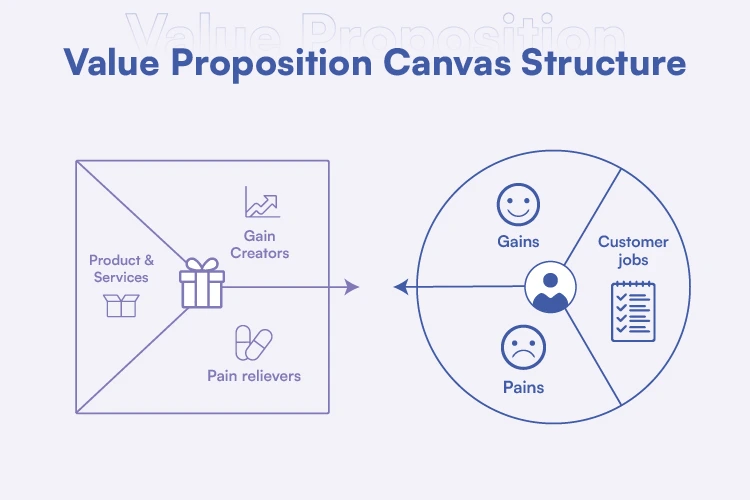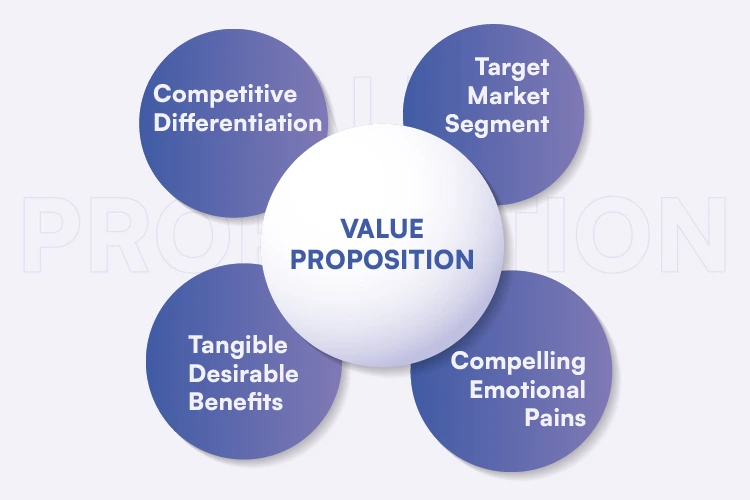You may have questioned at some point how project managers arrive at the intrinsic value of your product, what factors they use to set the parameters, and whether they are based on the money, time, and effort invested by the development team.
While this may sound simple, it might take quite some time to craft the ideal value proposition in some scenarios. As a product development firm, we know how important it is, to begin with the basics, such as the value proposition, when designing a product.
This blog will explain the reasoning behind this process as well as the factors that ultimately determine the product’s value proposition.
Grasping the concept of the Product Value Proposition
Some teams have already formulated the path, while others need a series of pathways to define the value proposition of the product they have been working on for a long time. There is good news: every product has its own unique value proposition, which makes it a perfect product-market-fit contender. Let’s look at how you can locate it.
But still, the big question remains: how is it possible to determine a value that, as mentioned above, is intangible and has no mode or means to measure it? That is where the ideology comes from, and what does it mean, define, justify, and how is it valued?
Product value is a summation of all the work that an organization does in planning, building, launching, marketing, selling, and supporting an offering. When you put it that way, it becomes clear that there will be more than one statistic used to determine the worth of a product. Value-based product development teams establish a common understanding of what makes a product valuable, which influences the metrics used to evaluate what gets developed and assess performance. Value is as the value does.
Meaning: You can say that no matter how much your product is specifically worth, it can only be true if it delivers on the value determined for it. This is the advantage that a particular product serves to the business, the professionals who created it, and the customer. The value is tangible or intangible.
What are the Different Types of Values?
Value is not one-dimensional. Multiple elements depend on how we perceive and evaluate the usage and benefits of a particular product. We should always remind ourselves that a customer’s experience with a product is contextualized. Every encounter that customers have, from the very first promotion they see to the customer service they get, contributes to the value evaluation they make.
The value of the product differs from industry to industry and product to product; there’s no universally selected formula or any documented thesis on how these things work, but it’s based on something else: the exact value of a product. This is the sole reason why most product teams spend hours evaluating all factors that impact how a customer perceives the worth of a product—from initial concept to well after launch.
Mapping corporate, product, and customer attributes to various types of value is the first step in the process of recording product value. This typically follows a more comprehensive company strategy. A product value statement can be used by other functional divisions like marketing, sales, and support to guide messaging and customer-facing materials.
The product value proposition is based on multiple facets, be they Scalability, Product USP, Time frame, Utility, or other factors that will combine and determine it.
A Value Proposition Canvas

You may assume it’s just a picture of a square and a circle, but this square (the value proposition) and circle (the customer profile) will help you understand market needs and how to meet them.
Customer Profile
The circle symbolizes the customer profile. When identifying end-user duties, difficulties, and desires, the circle’s three sections let you think like them.
Customer Jobs
Jobs encompass all of the tasks that consumers are attempting to do. These tasks can encompass anything that a customer is attempting to accomplish. It could be a problem solved, a job completed, or any need they desire to satisfy.
Jobs can be social, emotional, or functional.
Pains
Pains are any factors that prevent customers from completing a task; they are the hurdles that customers must overcome. Customers seek to avoid bad consequences, which are referred to as pains. Which is further classified as severe or light, assisting in the identification of problems from the customer’s perspective.
Gains
Positive experiences and objectives that customers wish to achieve are examples of gains. Gains can be mundane or existential. Gains, on the other hand, are not the inverse of pain. They are features that entice people to use a product or service.
Value Proposition
The canvas square is a visual representation of the three-part value proposition map. Every region corresponds to a client profile. Where you outline the product’s benefits, features, and functions that appeal to customers and satisfy their needs.
Products and Services
Here, list the goods, services, and features you offer. List the trial or free version of your product. Pay attention to how items and features help customers carry out their tasks.
Pain Relievers
Here, it is highlighted how your goods might lessen the suffering of the client. The client profile should be met by these pain relievers. Various pains necessitate various relievers.
Gain Creators
Here, you showcase the advantages your product has for users. How does your product help customers achieve success? List every innovation or practical aspect.
The Product Value Proposition in its Full Profundity
A product value proposition encapsulates why a customer would prefer your product over others. It is a brief statement highlighting the benefits clients will receive when they buy from your firm, use your product, and connect with your team.
Understanding the intricacies may aid you in developing a more comprehensive definition of your product’s value, allowing you to make smarter decisions and keep the team focused on what is most important.
A product value proposition is often a by-product of a company’s broader business strategy. A second session will be held to brainstorm and capture all aspects of the company, product, and consumer to inform the eventual product value proposition. While gathering a wide range of data, the purpose of this exercise is to answer one question: what are customers buying?
The Framework for a Product Value Proposition
It can be good to start with the key issue your product solves when crafting a product value proposition, followed by a list of features and advantages that customers will experience. You can arrange your information using the structure provided below.
Three major decisions will determine how the value proposition will be based, and those three factors will implement the value. The higher the points it clicks, the better the response.
| Product-focused questions | Customer-focused questions | Company-focused questions |
|
|
|
The best place to start when figuring out the genuine worth of your product is from the customer’s perspective, even though a product provides value to an organization (via market share, income, etc.). The four categories that traditionally contribute to customer perceptions of value are as follows:
- Functional Value is derived from the practical benefit of utilizing a product and how well it addresses an intended problem.
- Psychological Value is the value that considers the feel of the product, how it makes a buyer feel, and how it aligns with their identity.
- Monetary Value is the estimated worth of a thing concerning its pricing and customers’ willingness to pay.
- Social Value pertains to how well the audience connects with the product as well as the other audience members who use it and how being linked with the product affects them.
After analyzing the above topics, you can divide the various value types into two groups: Tangible and Intangible.
| Tangible (value for a SaaS product) | Intangible (value for a SaaS product) |
|
|
However, the big question arises. What determines the Value of a Product?
Value varies from industry to industry and from product to product. The precise value of a product cannot be calculated using a single, universal formula. This is why the majority of product teams invest time in analyzing every aspect that affects how a consumer values a product, starting with the initial concept and continuing long after launch.
Mapping corporate, product, and customer attributes to various types of value is the first step in the process of recording product value. This typically follows a more comprehensive company strategy. Senior product leaders will summarize this research into a product value proposition and product value statement, which the product team may use as a compass for planning its roadmap and prioritizing features.
The basis of the good proposition of a product depends on its ability to go to market and make necessary amends to disrupt the market; this key factor is what will be making its place as the major factor when determining the value of a product.

Dos and Don’ts of the Product Value Proposition
The things to include are: The Dos
- Outline Core Benefit: Explain how your product development company may help your target clients by solving a specific problem or filling a demand clearly and concisely.
- Based on Enterprise Values: Unique Selling Emphasize the value your organization provides to clients, such as cost savings, increased productivity, higher-quality products, or improved user experiences.
- Identify Unique Selling Points: Decide what makes your product development company unique from rivals and emphasize it. This may include experience in particular industries, cutting-edge methods, or a proven track record.
- Identify Pain Points: Address the problems or difficulties that your target clients encounter, and then describe how your product development solutions can resolve those problems.
- Send a Clear Message: Make sure your value proposition is easy to grasp and employs language that appeals to your target audience by using clear, succinct language. Avoid using technical terms that could mislead prospective clients.
Here’s a list of things to avoid: The Don’ts
- The idea is Ambiguous: While it’s essential to emphasize the advantages of your offerings, refrain from making implausible claims or overstating your qualifications. Be sincere and open while describing the services your business can provide.
- Overblown Claims: Make sure you comprehend the needs of your target market. Make sure your value proposition is informed by rigorous market research rather than assuming you know what clients want.
- Leaving out Market Research: Although it’s crucial to highlight key aspects, stay away from becoming overly technical or inundating buyers with a long list of features. Instead, focus on the advantages and results that your features make possible.
- Solely based on Features: When possible, provide examples of success to support your value argument. This could include case studies, client recommendations, or statistics that show how your product development company has benefited past customers.
- Ignoring Evidence Points: When possible, provide examples of success to support your value argument. This could include case studies, client recommendations, or statistics that show how your product development company has benefited past customers.
The long-running question over whether measuring Product Value is Important
You may have heard the adage, “What gets measured gets managed.” You can estimate, gauge, and gradually raise the value of your product if you can define what value is. Assigning a starting value score before development, then updating and monitoring how that score evolves throughout the development process, and finally through delivery, is the cornerstone of value-based product development. You will be able to choose metrics to track the value of your product over time once you have established its value.
Remember that your value proposition should be customer-centric, express your unique value clearly, and distinguish your product development company from the competition. As your firm grows and new opportunities develop, assess and modify your value proposition regularly.
With the product value proposition now at your disposal, your organization could benefit from integrating with other go-to-market strategies that are beneficial in delivering an exclusive product market fit.




